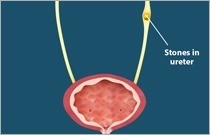Ureteric Stones

The urinary system, comprised of the kidneys, ureters, bladder, and urethra, purifies the blood by removing waste substances and excretes them from the body in the form of urine. Urine is produced in the kidneys and passes through tube-like structures called ureters to reach the bladder. A urinary tract stone is formed by crystallization of substances (mostly calcium) in the urine. As the kidneys filter blood of impurities, minerals and acid salts can accumulate and harden over time. These solid crystalline deposits or kidney stones can form in one or both kidneys and may get lodged in the ureters (called ureteric stones). The ureteric stones block the flow of urine and can cause severe pain in the flank, lower abdomen and groin. Other symptoms may include blood-stained or foul smelling urine, frequent urination, and/or fevers. If fevers occur, this can represent a life threatening emergency and you should present to the emergency department of your nearest hospital straight away.
When ureteric stones are suspected, your doctor may order blood, urine, and imaging tests such as a low radiation dose CT scan to diagnose the condition. A stone analysis may be carried out to determine the cause of the stone formation. This involves straining the urine for stone particles which are then examined in the laboratory.
Treatment of an ureteric stone depends on its size, location, and symptoms. Small stones (under 4mm) can be assisted to pass by certain medications and drinking fluids in many instances. Additionally, your doctor may prescribe analgesic medication to relieve pain in waiting for the stone to pass. For larger stones, your doctor may suggest certain procedures based on the location and size of the stone. When stones are larger or fail to progress, a ureteric stent maybe inserted to temporarily relieve the obstruction.
Definitive treatment your doctor may suggest include performing either shock wave lithotripsy or undergoing an ureteroscopy. With this latter procedure, a thin lighted tube called a ureteroscope is inserted through the urinary passage. Once the stone is located, it can be fragmented using a laser fibre and the fragments removed using basket shaped instruments at the end of the scope.





 Menu
Menu


